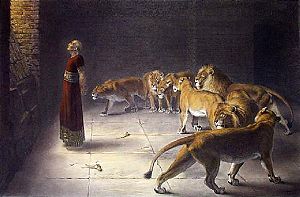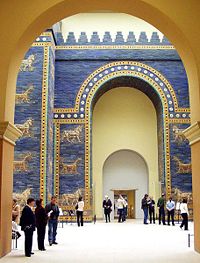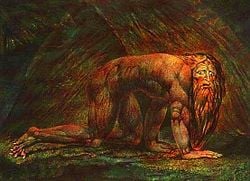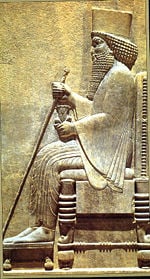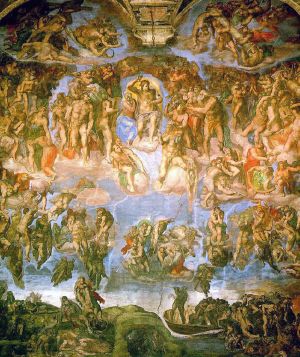Book of Daniel
| Books of the |
The Book of Daniel, written in Hebrew and Aramaic, is a book in both the Hebrew Bible and the Christian Old Testament. The book is set during the Babylonian Captivity, a period when the Jews had been deported and exiled to Babylon. It revolves around the figure of Daniel, an Israelite who becomes an adviser to Nebuchadnezzar, the ruler of Babylon from 605-562 B.C.E.
The book has two distinct parts: a series of six narratives (chapters 1-6) and four apocalyptic visions (chapters 7-12). The narratives take the form of court stories which focus on tests of religious fidelity involving Daniel and his friends (chapters 1, 3, and 6) and Daniel's interpretation of royal dreams and visions (chapters 2, 4 and 5). In the second part of the book, Daniel recounts his reception of dreams, visions, and angelic interpretations, speaking in the first person.
The dating and authorship of Daniel has been a matter of great debate. The traditional view holds that the work was written by Daniel, a prophet who lived during the sixth century B.C.E., whereas most modern biblical scholars maintain that the book was written in large part during the mid-second century B.C.E. and that most of the predictions of the book refer to events that had already occurred. A third viewpoint places the final editorial work in the fourth century B.C.E.
Content
Court narratives
The first six chapters of the Book of Daniel present a series of court tales, instructive narratives, and miracle tales.
1. Training in Babylon. After being taken captive to Babylon, Daniel and his friends, Hananiah, Mishael and Azariah—all of whom are members of the Jewish nobility—are treated well. They receive new names—Daniel is Belteshazzar, and his friends become Shadrach, Meshach, and Abednego. They are to be trained for three years as courtiers, learning the language, literature, and customs of Baylon. However, they decline consume the non-kosher royal diet. Their overseer worries that they will appear unhealthy, but after ten days on a strictly vegetarian diet, the appear healthier-looking than any other young men at court. Entering the presence of Nebuchadnezzar, they are found not only to be good looking, but even wiser and more skilled than any of the kings advisers and magicians.
2. Nebuchadnezzar's Dream. Nebuchadnezzar dreams of an idol made of four metals and a mixture of iron and clay. The image is destroyed by a rock that then dominates the world. None of the Babylonian astrologers and wise men can tell the king the content of his dream or interpret it, and he orders all of them to be put to death, and Daniel and his friends are to be included in this punishment. Daniel pleads for time to interpret the dreams. After he and his friends pray, Daniel receives a vision revealing the mystery. He tells Nebuchadnezzar what he dreamed and interprets the dream as a series of successive empires ending with God's kingdom. The king is so impressed that he does obeisance to Daniel, placing him over royal wise men and appointing Shadrach, Meshach and Abednego as "administrators over the province of Babylon."
3. Fiery Furnace. Nebuchadnezzar creates a golden statue of himself and requires all of his officials to bow before it, on pain of death by fire. Shadrach, Meshach, and Abednego refuse on religious grounds, believing that God will save them from the flames. They are thrown into a furnace, but God indeed preserves them. Nebuchadnezzar sees them and a fourth figure walking unharmed in the furnace. Bringing the three out, they are completely untouched by the flames. The king now declares that no one must speak against the God of the Israelites, and he gives the three Hebrews a further promotion in the Babylonian administration.
4. Madness of Nebuchadnezzar. In this chapter, Nebuchadnezzar at first speaks in the first person. He is now apparently a convert to belief in the Hebrew God. He tells the readers of his dream of a tree so tall that it touches the sky: "Its leaves were beautiful, its fruit abundant, and on it was food for all.
Under it the beasts of the field found shelter, and the birds of the air lived in its branches; from it every creature was fed." A "holy one" instructs that the tree be cut down, and its "stump" be transformed from a man to an animal. No one but his chief magician, Daniel/Belteshazzar can interpret the dream. He regretfully informs the king that he himself is the tree, and that he will be driven insane, living with the animals and eating grass with the cows, for seven "times." The prophecy is fulfilled a year later as Nebuchadnezzar hears a voice from heaven and promptly goes insane. Only when he accepts Daniel's God as his own and repents of his sin does he regain his sanity.
5. Writing on the Wall. Belshazzar, the son of Nebuchadnezzar now reigns. He gives a royal banquet but insults Daniel's God but having his guests drink from from gold and silver goblets which had been removed from the Temple of Jerusalem. A mysterious hand appears out of nowhere and writes four words on the wall. The king is aghast, and only Daniel can read the words: mene, mene, tekel, upharsin. Daniel interprets them as:
- Mene: God has numbered the days of your reign and brought it to an end.
- Tekel: You have been weighed on the scales and found wanting.
- Upharsin: Your kingdom will be divided and given to the Medes and Persians.
6. Lions' Den. Now the king is Darius of Persia. He issues an edict that anyone who prays to any god other than himself in the next 30 days will be thrown into a den of lions. Daniel refuses to comply and is thrown to the lions, but they do not devour him. The next day, Daniel informs the amazed king that an angel was sent by God to shut the mouths of the lions. Darius then decrees that Daniel's God be revered throughout the land.
Two other chapters are included in the authorized Catholic version of the Bible, which are not included in the Hebrew Bible or Protestant versions of the Old Testament. These are Susana and the Elders (also called Daniel and Susana or simply Susana) and Bel and the Dragon. In addition, the Catholic version includes a prayer of Azariah in the fiery furnace, a brief account of the angel who met them in the furnace, and a hymn of praise sung by the Hebrew youths when they were delivered.
Apocalyptic visions
The remaining chapters of the Book of Daniel are visionary, an early example of apocalyptic literature, in which the author, now speaking in the first person, experiences visions entrusted to him alone. One feature of this section is Daniel's reliance on heavenly figures to interpret and explain his visions. The historical setting of the first chapters does not appear, except in indicating the regnal dates in which the visions occur. This section also, like the first, consists of text from two languages, the first 26 verses originally in Aramaic, the rest (chapters 8-12) in Hebrew.
This apocalyptic part of Daniel consists of three visions and one prophetic communication, mainly having to do with the destiny of Israel:
- In the first year of Belshazzar's reign, Daniel sees a vision of concerning four terrifying beasts representing four future kings or kingdoms. Also included in this chapter is Daniel's vision of a "son of man, coming with the clouds of heaven," who is given eternal dominion of the earth by God, seen by Christians as a prophecy of the Second Coming of Christ (7:13). The fourth beast in the vision devours the whole earth, treading it down and crushing it (7:23). This beast has ten horns representing ten kings: an empire. A blasphemous king arise and rules, oppressing the saints for three and a half years. However, this person is judged and his dominion is taken away (7:26). Then dominion of heaven and earth is given to the people of the saints of the Most High (7:27).
- In Belshazzar's third year Daniel sees a ram and a male goat (8:1-27) which represent Medo-Persia and Greece. The vision focuses on a wicked king who arises to challenge the "army of the Lord" by removing the daily [[Temple of Jerusalem|Temple}} sacrifice and desecrating the sanctuary for a period of 2,300 days. Daniel becomes ill after receiving this vision, admitting that, "I was appalled by the vision; it was beyond understanding."
- In the first year of Darius the son of Ahasuerus of Persia Daniel receives a prophecy concerning 70 weeks—or seventy "sevens." Daniel meditates on the prediction in the Book of Jeremiah that the desolation of Jerusalem would last 70 years and pleads for God to restore holy city and it's Temple. An angel reveals to him that after a certain period, the Messiah will come and begin the rebuilding, but he will be "cut off," and a wicked ruler will arise who will desecrate the Temple and put an end to sacrifices and offerings.
- In the third year of Cyrus of Persia, Daniel receives a lengthy vision regarding conflicts between the "King of the North" and the "King of the South." Starting with references to Persia and Greece it culminates in the description of an arrogant king who desecrates the Temple, sets up a "desolating abomination," removes the daily sacrifice, and persecutes those who remain true to the "holy covenant."
Historical problems
Some modern historians of Babylonia or Achaemenid Persia do not adduce the narratives of Daniel as source materials, as they consider some statements in Daniel to be in conflict with other historical accounts. However, a major critic of Daniel, H. H. Rowley considered chapter 11 as "a first-class historical source for that period"[1] But, Raymond Dougherty, an eminent scholar in this field, pointed out: "Of all the non Babylonian records dealing with the situation at the close of the Neo-Babylonian empire the fifth chapter of Daniel ranks next to cuneiform literature in accuracy so far as outstanding events are concerned." [2] However, this stated, it is clear that Dougherty ranks the cuneiform literature as first in accuracy.
The four objections given below represent, in order of significance, the major instances of error historians generally find in Daniel.
Identity of "Darius the Mede"
The personage whom Daniel describes as taking control of Babylon after Belshazzar is deposed is named as Darius the Mede, who rules over Babylon in chapters 6 and 9. Daniel reports that Darius was 'about 62 years old' when he was 'made king over Babylon.'
As Darius the Mede is unknown to any other source (except Flavius Josephus, many historians view his presence in Daniel as simply a mistake of a much later author, who has inadvertently placed the historical Persian King Darius I at an earlier date than when he actually reigned. Among writers maintaining an early date for the Book of Daniel, there are several interpretations of the identity of Darius the Mede. One view concludes that Darius is another name for Cyrus the Great. Another view is that Darius is another name for the historical figure of Gubaru (sometimes spelled as Ugbaru). A third view sees Darius as another name for Astyages, the last Mede king, who was ultimately deposed by Cyrus. Josephus makes Darius the son of Astyages and the uncle of Cyrus. Calvin and others identify Darius the Mede with a certain Cyaxares II.[3]
Belshazzar
For many years Belshazzar was an enigma for historians. The book of Daniel states that he was “king” the night that Babylon fell (chap. 5) and that his father was Nebuchadnezzar (5:2, 11, 13, 18). Prior to 1854, archeologists and historians knew nothing of Belshazzar outside the book of Daniel. From that time, new evidence from Babylon has verified the existence of Belshazzar, as well as his co-regency during the absence of his father—who was not Nebuchadnezzar but Nabonidus. In the Nabonidus Cylinder, Nabonidus petitions the god Sin as follows: “And as for Belshazzar my firstborn son, my own child, let the fear of your great divinity be in his heart, and may he commit no sin; may he enjoy happiness in life." Another statement indicates that Nabonidus "entrusted the kingship" to Belshazzar.
The available information concerning Belshazzar's regency goes silent after Nabonidus' fourteenth year. According to the Nabonidus Chronicle, Nabonidus return from Temâ by his seventeenth year. There is no evidence that Belshazzar officially held the title of "king." No known extrabiblical text indicates a blood relation between Nebuchadnezzar and Belshazzar.
Madness of Nebuchadnezzar
A third significant objection by historians is the account of the insanity suffered by Nebuchadnezzar found in the fourth chapter of Daniel. However, in the Dead Sea Scrolls a fragment known as The Prayer of Nabonidus discusses a disease suffered by Nabonidus, and there are obvious parallels, as well as important differences between the two accounts. In indeed Daniel is mistaken regarding Nebuchadnezzar's madness, an obvious explanation may simply be that its author confused Nabonidus with Nebuchadnezzar, just as he mistakenly identified Belshazzar as Nebuchadnezzar's, son instead of the son of Nabonidus.
Dating
Traditionally, the Book of Daniel was believed to have been written by its namesake during and shortly after the Babylonian captivity in the sixth century B.C.E. Although this view continues to be held by traditionalist Christians and Jews, it has been discredited by critical scholars. These scholars propose that, since Antiochus IV Epiphanes desecrated the altar of the Temple of Jerusalem around 167 B.C.E., the Book of Daniel (in its final form) was written in reaction to that incident. This theory also explains why the the writer(s) seems so confused about the history of the kings of Babylon and Persia.
The critical view thus affirms that, rather than being a prophecy of time to come, the book is intends to explain the spiritual meaning of the history already experienced by the Jews of the second century, who had recently experienced a particularly harsh persecution under Antiochus Epiphanes. It may have been used by the supporters of the Maccabeean revolt to mobilize popular support for their cause, which was ultimately successful in conquering Jerusalem and rededicating the Temple.
Influence
Judaism
Daniel's visions contributed to an increasing diversity of views in first century Judaism on such issues as salvation, resistance to Gentile rule, angels, resurrection, and the nature and mission of the Messiah. Daniel was a highly popular book among Jews prior to and during New Testament times. Along with the Book of Enoch and other apocalyptic literature it was a major contributing factor to a trend within Judaism that looked to dramatic supernatural events, as well as political and social change, in the events leading up to the coming of the Messiah. Indeed, the Messiah himself is described in Daniel not as the earthly descendant of king David, but as a heavenly "son of Man" who comes on the clouds to rule the entire earth forever (Dan. 7:13).
Rabbinical thought of the early talmudic era tended to discourage apocalyptic and messianic expectations, especially in the wake of the catastrophic Bar Kochba rebellion in which many tens of thousands of Jews lost their lives. Much popular apocalyptic literature literature was thus excluded from the Hebrew Bible, although some was accepted into the New Testament canon as the Apocrypha of the Old Testament. Daniel was accepted, but not as one of the works of the prophets. Instead it is included as one of the Writings, and appears later in the order of the biblical books than it does in the Christian Bible.
Christianity
The various episodes in the first half of the book are used by Christians as faith-inspiring moral stories, and are often believed to foreshadow events in the gospels.
The apocalyptic section is important to Christians for the image of the "Son of Man" (Dan. 7:13), interpreted as referring the Second Coming of Jesus on the clouds. According to the gospels, Jesus used this title as his preferred name for himself. The connection with Daniel's vision (as opposed to the usage of "son of man) in the Book of Ezekiel) is made explicit in the Gospels of Matthew and Mark (Matt 26:64; Mk 14:62). Christians see this as a direct claim by Jesus that he is the Messiah.
Traditional Christians have also embraced the prophetic visions of Daniel. In the Olivet discourse (Mark 13:14, Matthew 24:15), Jesus himself is quoted as applying Daniel's prophecy of a desolating sacrilege to a future event—-either the [[siege of Jerusalem (70 C.E.), or a future Antichrist immediately preceding Judgement Day. Some Christians consider the Prophecy of Seventy Weeks to be particularly compelling due to what they interpret to be prophetic accuracy. The Book of Daniel also seems to have been an important influence on the writer of the Book of Revelation, whose dramatic imagery of a symbolic beast rising from the sea representing an an evil ruler who persecutes the saints bears marked similarities to that of Daniel.
See also
Notes
- ↑ H. H. Rowley, The Growth of the Old Testament, Harper: 1950, p. 158)).
- ↑ Nabonidus and Belshazzar, Yale: 1929, p. 199
- ↑ Much of this Cyaxares II is related in Xenophon's Cyropaedia 1.4,7, iii.3, 20, viii.5, 19, causing many other scholars to suppose he is the Darius described by Josephus; however this king's omission from Ctesias and Herodotus has caused other scholars (eg. Blum, Fred P. Miller) to question his existence.
ReferencesISBN links support NWE through referral fees
- John J. Collins, Daniel: A Commentary on the Book of Daniel, 1993. ISBN 0-8006-6040-4.
- E. J. Bickerman, Four Strange Books of the Bible, 1967. ISBN 0-8052-0774-0.
- Pierre Briant, From Cyrus to Alexander. Librairie Artheme Fayard (Paris), 1996. (Translation by Peter Daniels, 2002) p. 42.
- Louis F. Hartman and Alexander A. Di Lella, "Daniel," in Raymond E. Brown et al., ed., The New Jerome Biblical Commentary, 1990, pp. 406-20.
- William H. Shea, "The Prophecy of Daniel 9:24-27," in Holbrook, Frank. ed., The Seventy Weeks, Leviticus, and the Nature of Prophecy, 1986, Daniel and Revelation Committee Series, Vol. 3, Review and Herald Publishing Association.
- D.J. Wiseman, T.C. Mitchell & R. Joyce, W.J. Martin & K.A. Kitchen, Notes on Some Problems in the Book of Daniel. London: The Tyndale Press, 1965.
- [http://www.prophecy101.freeservers.com
- A symposium of Daniel by conservative scholars.
- Easton's bible dictionary
External links
- Jewish translations:
- Daniel (Judaica Press) translation with Rashi's commentary at Chabad.org
- Christian translations:
- Online Bible at GospelHall.org
- Daniel at The Great Books (New Revised Standard Version)
- Daniel at Wikisource (Authorised King James Version)
- The Book of Daniel (Full text from St-Takla.org, also available in Arabic)
Related Articles:
- Daniel at iTanakh
- Jewish Encyclopedia: Daniel
- Daniel: Wise Man and Visionary, by Elias Bickerman
- Daniel by Rob Bradshaw Detailed dictionary-style article.
Credits
New World Encyclopedia writers and editors rewrote and completed the Wikipedia article in accordance with New World Encyclopedia standards. This article abides by terms of the Creative Commons CC-by-sa 3.0 License (CC-by-sa), which may be used and disseminated with proper attribution. Credit is due under the terms of this license that can reference both the New World Encyclopedia contributors and the selfless volunteer contributors of the Wikimedia Foundation. To cite this article click here for a list of acceptable citing formats.The history of earlier contributions by wikipedians is accessible to researchers here:
The history of this article since it was imported to New World Encyclopedia:
Note: Some restrictions may apply to use of individual images which are separately licensed.
